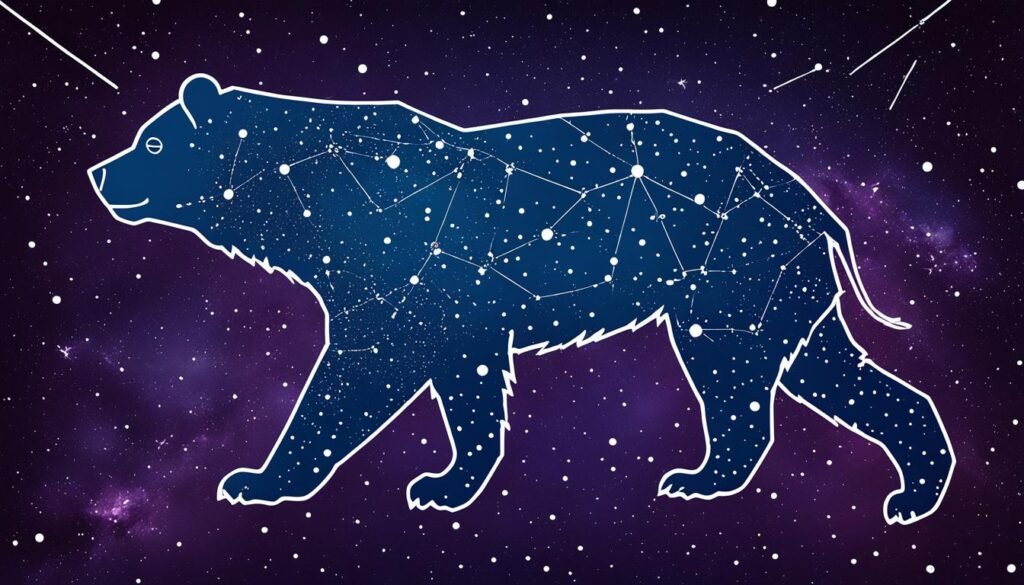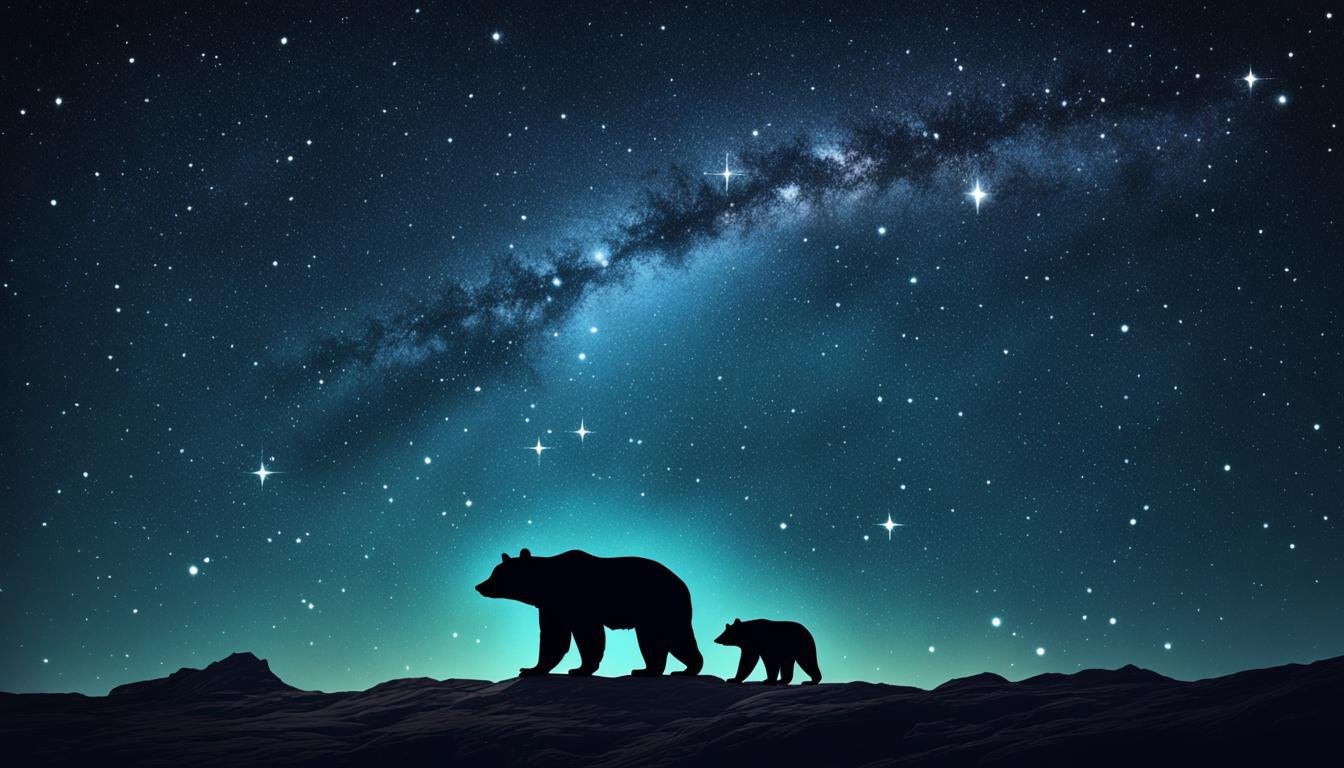| Genitive | |
| Abbreviation | |
| Pronunciation | |
| Main Stars | |
| Brightest Star | |
| Right Ascension | |
| Declination | |
| Sq. Deg. Area | |
| Crosses Meridian | |
| Visible Lat. Range |
As you gaze into the northern sky, the constellation Ursa Major beckons with its aura of timeless myth and cosmic wonder. Known widely as the Great Bear constellation, this celestial feature is not only a feast for the eyes but a repository of stories and a guardian for navigators. The Ursa Major constellation, holding court in the expanse above, is an ancient guidepost studded with Ursa Major constellation facts that have enlightened humanity throughout the ages.
The secrets of the Great Bear await to be unlocked as you explore the sizeable astral bear occupying 1280 square degrees of the night sky. Whether you’re an astute astronomer or a casual stargazer, the constellation Ursa Major serves as a beacon throughout much of the Northern Hemisphere, visible at every hour of the year, and rich with celestial tales and cosmic marvels.
Key Takeaways
- The constellation Ursa Major is also referred to as the Great Bear.
- Home to the Big Dipper, the constellation is deeply etched in human culture and history.
- It is one of the largest constellations and a key fixture in the northern night sky.
- The constellation is bordered by Draco, Leo, Boötes, and other notable constellations.
- Ursa Major is visible year-round in the Northern Hemisphere.
- Rich in mythology, Ursa Major has been catalogued since the times of Ptolemy in the 2nd century.
- The constellation is a vital tool for navigation, leading to Polaris, the North Star.
Exploring the Stars of Ursa Major Constellation
As you gaze up into the northern skies, the Ursa Major stars form a celestial tapestry that has guided humanity for millennia. Amongst these stars, the most luminous and easily recognizable are the ones forming the iconic Big Dipper asterism. The constellation is renowned for its seven brightest stars, but did you know there are 22 named stars within its expanse? Let’s delve into the brilliant beacons that make up this ancient constellation.
Each star within the Ursa Major constellation has a story to tell, and perhaps none shines brighter in that narrative than Alioth, also known as Epsilon Ursae Majoris. As the brightest star in Ursa Major, Alioth is a beacon in the void, leading the charge in the constellation’s famed asterism. Following closely are Dubhe and Alkaid, which radiate with a brilliance that has captured the imaginations of cultures worldwide, playing a pivotal role in navigation and the very understanding of our heavens.
| Star Name | Designation | Apparent Magnitude | Distance (Light Years) |
|---|---|---|---|
| Alioth | Epsilon Ursae Majoris | 1.76 | 82 |
| Dubhe | Alpha Ursae Majoris | 1.79 | 123 |
| Alkaid | Eta Ursae Majoris | 1.85 | 103 |
| Mizar | Zeta Ursae Majoris | 2.04 | 78 |
| Megrez | Delta Ursae Majoris | 3.31 | 81 |
| Phecda | Gamma Ursae Majoris | 2.44 | 83 |
| Merak | Beta Ursae Majoris | 2.37 | 79 |
The wider family of Ursa Major is not to be overlooked either. This illustrious group of constellations houses several neighboring patterns, each with their tales waiting to be uncovered. From its brightest stars to its more subdued celestial residents, the Ursa Major constellation captures the essence of the night sky’s grandeur and continues to be a cornerstone for those who seek to unravel the mysteries of the cosmos.
Historical and Cultural Significance of Ursa Major
The grand tapestry of the night sky is rich with stories, and the epic narrative of Ursa Major is no exception. This magnificent constellation is not just a cluster of stars; it’s a canvas that carries the myths and navigation history of ancient and modern civilizations alike. Marvel at the constellation’s mythological past and learn how it has led many travelers through the ages to their destinations under the celestial compass.
Ancient Myths and the Legends of the Great Bear
In the annals of history, few celestial figures are as storied as Ursa Major. The Ursa Major mythology unfolds with the tale of Callisto, a narrative rooted in Greek mythology that has permeated cultures worldwide. Transformed into a bear and set among the heavens, her story captures the imagination and has been retold through countless generations. Resonating differently across cultures – from the Roman’s Septentrio to the Hindu’s Saptarshi – the constellation has been a spectral tapestry onto which people have projected narratives of gods, creatures, and legends.

Below you will find a table that captures a selection of the diverse cultural interpretations of Ursa Major:
| Culture | Interpretation of Ursa Major | Notable Legend/Usage |
|---|---|---|
| Greek | The Great Bear | Myth of Callisto |
| Roman | Septentrio, Seven Northern Oxen | Roman Ploughing |
| Arab | Funeral Procession/Coffin | Navigation and Literature |
| Chinese | Governing Authority/Northern Measure | Imperial Astrology |
| Hindu | Seven Sages (Saptarshi) | Vedic Scriptures |
| Native American | A Great Bear | Creation Stories and Season Changes |
Ursa Major’s Role in Navigation and Astronomy
While Ursa Major’s tales of old captivate the soul, its enduring practical role in navigation by stars cannot be overstated. The Big Dipper, part of the larger constellation, serves as a celestial guidepost pointing the way to the North Star, Polaris, a beacon of constancy in a perpetually changing night sky. The relationship between the Big Dipper’s pointer stars, Dubhe and Merak, and Polaris has long been a navigator’s trusted tool, offering assurance and direction throughout the centuries.
- Dubhe and Merak as guides to locate Polaris, the North Star
- The prevalence of the Big Dipper mythology in navigation
- Ursa Major star map’s role in maritime and terrestrial navigation
- Significance of Ursa Major to the Underground Railroad
Through the vast corridors of time, the prominence of these stars in ancient and modern narratives of discovery and exploration cement Ursa Major’s place not only in the domain of story and legend but also as an instrumental guide in our human journey beneath the stars.
The Distinctive Formation of the Big Dipper
When you gaze into the night sky, one of the most familiar sights is the Big Dipper, known also as the Plough asterism. This group of stars is not only a landmark in the cosmos but also an enduring symbol in various cultures. As part of the larger Ursa Major constellation, the Big Dipper stars have served as a celestial navigator for centuries, their reliability deriving from their near-permanent presence throughout the year for observers in the northern hemisphere.
Let’s take a closer look at each of the star players forming the Big Dipper:
- Dubhe: The second brightest star in Ursa Major and one of the pointer stars that lead stargazers to Polaris, the North Star.
- Merak: Together with Dubhe forms what is commonly known as the “pointer stars.”
- Phecda: A star with a slight golden hue situated at the bend of the Big Dipper’s handle.
- Megrez: The faintest of the seven stars, where the handle connects to the bowl.
- Alioth: The brightest star in the Big Dipper and the Ursa Major constellation.
- Mizar: This binary system can be observed with the naked eye, and close to it is its fainter companion, Alcor.
- Alkaid: A star marking the end of the handle, it is also known as Benetnash.
The Big Dipper doesn’t just form a distinct shape; it also demonstrates the dynamism of our cosmos as the majority of its stars belong to the Ursa Major Moving Group. This means they share a common motion through space, adding another layer to their collective story.
| Star Name | Apparent Magnitude | Spectral Type |
|---|---|---|
| Dubhe | 1.79 | K0III |
| Merak | 2.37 | A1V |
| Phecda | 2.44 | A0V |
| Megrez | 3.32 | A3V |
| Alioth | 1.76 | A0p |
| Mizar | 2.23 | A2V |
| Alkaid | 1.85 | B3V |

The formation of the Big Dipper isn’t just for stargazers to marvel at; it’s an emblem that’s steeped in history, revealing the intricacies of our universe’s architecture. Whether you use it as a tool for navigation or as a pathway to ancient stories, the stars of the Plough asterism continue to guide and inspire.
Deep Sky Wonders Within Ursa Major
Among the sprawl of night sky constellations, Ursa Major houses a treasure trove of deep sky objects that are bound to awe even the most seasoned stargazers. You may have traced the outline of The Great Bear, but within its borders lie cosmic spectacles such as the majestic whirls of the Pinwheel Galaxy (M101). With arms that stretch through space, this grand spiral galaxy is a classic face-on view, allowing you to ponder the intricacies of galactic structures from Earth.
Another feast for the eyes is the Owl Nebula. Its haunting symmetrical features evoke the watchful eyes of an owl in flight, nestled within the Ursa Major borders. Similar in grandeur, Bode’s Galaxy acts as a celestial lighthouse, its bright core a beacon in the dark expanse. The Cigar Galaxy, with its vibrant starburst activity, reminds you of the fierce furnace of star creation, a process happening right before your cosmic doorstep.
The Ursa Major constellation doesn’t stop at dazzling with stars and asterisms; it holds within it galaxies that not only add to its beauty but also serve as windows into universal phenomena. By observing these deep sky jewels—each a wondrous collection of stars, dust, and gas—you’re witnessing the story of the universe unfolding. From galactic collisions to the dance around invisible supermassive black holes, Ursa Major offers a profound glimpse into realms far beyond our own. So next time you gaze up at the sprawling paws of The Great Bear, remember you’re not just staring at stars but gazing into the depths of space and time itself.
FAQ
What is the Ursa Major constellation?
The Ursa Major constellation, also known as the Great Bear constellation, is a prominent constellation in the northern sky, featuring well-known asterisms such as the Big Dipper and containing a wide array of stars and deep-sky objects. It’s the third-largest constellation in the night sky, visible throughout the year in most of the Northern Hemisphere.
Can you name the brightest stars in the Ursa Major constellation?
The brightest stars in the Ursa Major constellation include Alioth, Dubhe, and Alkaid, which are part of the Big Dipper asterism. These and other bright stars such as Merak and Phecda contribute to the constellation’s recognition and visibility in the night sky.
What myths are associated with the Ursa Major constellation?
Various myths and legends are tied to the Ursa Major constellation, with one of the most well-known being the Greek myth of Callisto, who was transformed into a bear and placed in the sky by Zeus. The constellation also features in the mythologies and cultural stories of Ancient Rome, Arab cultures, Chinese beliefs, Hindu traditions, and several Native American tribes.
How has the Ursa Major constellation been used for navigation?
Historically, Ursa Major has been crucial in navigation due to its circumpolar nature and the fact that it houses the Big Dipper, which effectively points towards Polaris, the North Star. Specifically, the “pointer” stars Dubhe and Merak guide one to find Polaris and, hence, determine true north, catering to travelers and sailors in the past and serving as a beacon of direction for those following the Underground Railroad in American history.
What is the significance of the Big Dipper?
The Big Dipper, or the Plough asterism, is a distinctive formation within the larger Ursa Major constellation, made up of seven major stars. It has served as an important celestial guidepost due to its recognizable shape and as a navigational aid in finding the North Star. Apart from its utility, the Big Dipper figures prominently in worldwide cultural lore and mythologies.
What deep-sky objects are found in Ursa Major?
Ursa Major is home to several impressive deep sky objects that intrigue astronomers and stargazers. Notable among these are the Pinwheel Galaxy (M101), Bode’s Galaxy (M81), the Cigar Galaxy (M82), and the Owl Nebula (M97). These objects range from spiral galaxies to nebulas, and they provide a window into cosmic phenomena such as star formation and galactic structure.
What are some Ursa Major constellation facts?
Some interesting Ursa Major constellation facts include that it is one of the largest constellations in the sky, contains the well-known Big Dipper asterism, and has 22 named stars. It’s rich in mythology and has been used as a crucial navigation tool throughout history. Additionally, Ursa Major includes a number of Messier objects and deep sky wonders that make it a fascinating target for astronomical observation.
Why is Ursa Major often referred to as the Great Bear?
Ursa Major is often called the Great Bear due to its representation of a bear in various ancient mythologies, including Greek and Roman stories. The Latin name “Ursa Major” directly translates to “greater bear,” distinguishing it from Ursa Minor, the “lesser bear,” which includes the Little Dipper.
Are there any other names for the Big Dipper?
Yes, the Big Dipper is also commonly known as the Plough in the United Kingdom and Ireland. In various cultures, it has been recognized by other names that reflect its shape or the mythology surrounding the constellation.
How do the stories of Ursa Major vary across different cultures?
Ursa Major’s stories and interpretations vary widely among different cultures. In Greek mythology, it is associated with the nymph Callisto. Romans labeled it Septentrio. To the Arabs, it resembled a coffin, while Chinese legends saw it reflecting governmental authority. In Hindu culture, it was linked to the Saptarshi or the Seven Sages. Native American narratives often revolve around a bear and hunting. Each culture has enriched the tapestry of tales and symbolic meanings attached to this constellation.







